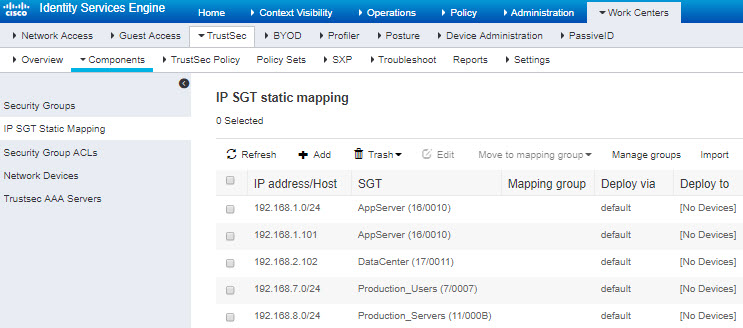Configure security groups and SXP publishing in ISE
There is a lot of configuration that you must do in Cisco Identity Services Engine (ISE) to create the TrustSec policy and security group tags (SGT). Please look at the ISE documentation for more complete information on implementing TrustSec.
The following procedure picks out the highlights of the core settings you must configure in ISE for the Firewall Threat Defense device to be able to download and apply static SGT-to-IP address mappings, which can then be used for source and destination SGT matching in access control rules. See the ISE documentation for detailed information.
The figures in this procedure are based on ISE 2.4. The exact paths to these features might change in subsequent releases, but the concepts and requirements will be the same. Although ISE 2.4 or later is recommended, and preferably 2.6 or later, the configuration should work starting with ISE 2.2 patch 1.
Before you begin
You must have the ISE Plus license to publish SGT-to-IP address static mappings and to get user session-to-SGT mappings so that the Firewall Threat Defense device can receive them.
Procedure
Step 1 | Choose , and select the Publish SXP Bindings on PxGrid option. This option makes ISE send the SGT mappings out using SXP. You must select this option for the Firewall Threat Defense device to “hear” anything from listing to the SXP topic. This option must be selected for the Firewall Threat Defense device to get static SGT-to-IP address mapping information. It is not necessary if you simply want to use SGT tags defined in the packets, or SGTs that are assigned to a user session.  |
Step 2 | Choose , and add a device. This does not have to be a real device, you can even use the management IP address of the Firewall Threat Defense device. The table simply needs at least one device to induce ISE to publish the static SGT-to-IP address mappings. This step is not necessary if you simply want to use SGT tags defined in the packets, or SGTs that are assigned to a user session.  |
Step 3 | Choose and verify there are security group tags defined. Create new ones as necessary.  |
Step 4 | Choose and map host and network IP addresses to the security group tags. This step is not necessary if you simply want to use SGT tags defined in the packets, or SGTs that are assigned to a user session.  |